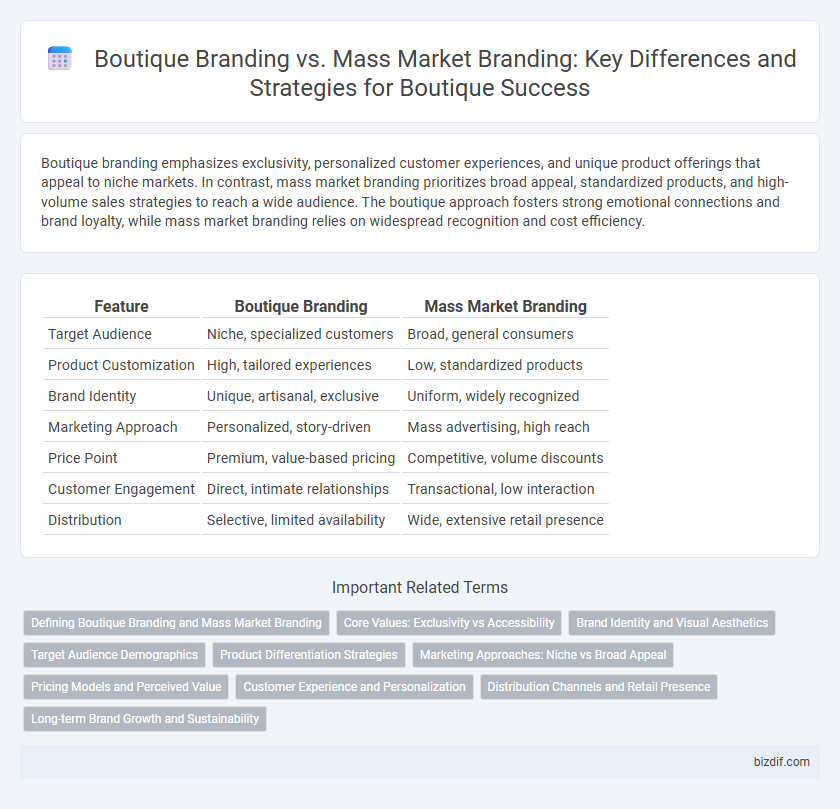Boutique branding emphasizes exclusivity, personalized customer experiences, and unique product offerings that appeal to niche markets. In contrast, mass market branding prioritizes broad appeal, standardized products, and high-volume sales strategies to reach a wide audience. The boutique approach fosters strong emotional connections and brand loyalty, while mass market branding relies on widespread recognition and cost efficiency.
Table of Comparison
| Feature | Boutique Branding | Mass Market Branding |
|---|---|---|
| Target Audience | Niche, specialized customers | Broad, general consumers |
| Product Customization | High, tailored experiences | Low, standardized products |
| Brand Identity | Unique, artisanal, exclusive | Uniform, widely recognized |
| Marketing Approach | Personalized, story-driven | Mass advertising, high reach |
| Price Point | Premium, value-based pricing | Competitive, volume discounts |
| Customer Engagement | Direct, intimate relationships | Transactional, low interaction |
| Distribution | Selective, limited availability | Wide, extensive retail presence |
Defining Boutique Branding and Mass Market Branding
Boutique branding emphasizes personalized experiences, niche markets, and unique, high-quality products tailored to specific customer needs. Mass market branding focuses on broad appeal, standardized products, and extensive distribution aiming for high volume and brand recognition across diverse consumer groups. The strategic difference lies in boutique branding's emphasis on exclusivity and authenticity versus mass market branding's scale and accessibility.
Core Values: Exclusivity vs Accessibility
Boutique branding emphasizes exclusivity, cultivating a brand identity grounded in unique, high-quality products that appeal to discerning customers seeking personalized experiences. Core values in boutique branding prioritize craftsmanship, limited availability, and niche appeal, creating strong emotional connections and loyalty. In contrast, mass market branding centers on accessibility, offering widely available products designed for broad appeal, prioritizing affordability, convenience, and standardized quality to attract large consumer bases.
Brand Identity and Visual Aesthetics
Boutique branding emphasizes a unique brand identity with personalized storytelling and handcrafted visuals, creating an exclusive emotional connection with a niche audience. Visual aesthetics in boutique branding often include bespoke logos, curated color palettes, and artisanal design elements that distinguish the brand from mass market competitors. In contrast, mass market branding relies on broad appeal, standardized visuals, and consistent messaging to generate recognition and trust across a wide customer base.
Target Audience Demographics
Boutique branding targets a specific, niche demographic characterized by distinct preferences, higher purchasing power, and a desire for unique, personalized experiences. Mass market branding appeals to a broader audience with diverse demographics, emphasizing affordability, accessibility, and widespread appeal. Understanding these demographic differences enables brands to tailor marketing strategies that align with consumer expectations and maximize engagement.
Product Differentiation Strategies
Boutique branding emphasizes unique product differentiation strategies by leveraging artisanal quality, personalized customer experiences, and niche market appeal to create exclusivity and strong brand identity. In contrast, mass market branding prioritizes broad appeal, consistent product features, and competitive pricing to attract a large, diverse customer base. Boutique brands often use limited editions and handcrafted elements to stand out, while mass market brands rely on standardized production and wide distribution channels.
Marketing Approaches: Niche vs Broad Appeal
Boutique branding emphasizes personalized marketing strategies tailored to a specific niche audience, leveraging exclusivity and deep customer engagement to build strong brand loyalty. In contrast, mass market branding employs broad appeal campaigns with wide-reaching messaging designed to attract diverse consumer groups, prioritizing high volume and consistent brand recognition. Strategic targeting in boutique branding involves curated content and intimate customer experiences, while mass market approaches utilize extensive media channels and generalized advertising to maximize reach.
Pricing Models and Perceived Value
Boutique branding employs premium pricing models that emphasize exclusivity and craftsmanship, enhancing the perceived value through personalized experiences and limited availability. Mass market branding typically adopts competitive pricing strategies aimed at affordability and wide accessibility, which can dilute perceived value due to product ubiquity. The contrast in pricing models directly influences consumer perception, with boutique brands leveraging scarcity to justify higher price points, while mass market brands focus on volume-driven sales.
Customer Experience and Personalization
Boutique branding emphasizes a highly personalized customer experience, fostering strong emotional connections through tailored services and exclusive product offerings that resonate with niche markets. Mass market branding focuses on broad appeal and consistency, leveraging standardized messaging and large-scale distribution to reach a wider audience with less individualized interaction. The boutique approach drives customer loyalty by prioritizing unique, immersive experiences, while mass market strategies maximize reach and efficiency across diverse consumer segments.
Distribution Channels and Retail Presence
Boutique branding emphasizes selective distribution channels, favoring exclusive retail stores, flagship locations, and curated online platforms to maintain a premium brand image. Mass market branding utilizes widespread distribution through supermarkets, large retail chains, and extensive e-commerce networks to maximize accessibility and volume sales. The retail presence of boutique brands is typically limited and highly curated, while mass market brands aim for broad visibility and convenience across diverse geographic locations.
Long-term Brand Growth and Sustainability
Boutique branding focuses on creating a unique, personalized customer experience that fosters deep brand loyalty and sustainable long-term growth by targeting niche markets. Mass market branding emphasizes broad appeal and high-volume sales, often sacrificing individual customer connection for scale, which can challenge sustained differentiation. Sustainable growth in boutique branding stems from authentic storytelling, exclusive offerings, and building strong emotional connections that mass market brands typically struggle to replicate.
Boutique Branding vs Mass Market Branding Infographic

 bizdif.com
bizdif.com